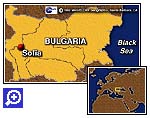


A Recent Article about Sofia from the New York Times (April 2006)
Quick Links:
Sofia, the capital of Bulgaria, is
the largest city with a population of 1.3 million and a dominant position in
the country's economic, political, and cultural life. 
Founded seven thousand years ago, Sofia is the second oldest city in Europe. It has been given several names in the course of history and the remnants of the old cities can still be seen today. It was built on a strategic location on the main road from West Europe to Constantinople, in a fruitful field surrounded from all sides by mountains and rich with mineral spas which have been famous since the Antiquity for the healing properties of their waters. In the middle of the first millennium BC the town was a capital of a Tracian tribe called "Serdi" and had the name "Serdica".
 The basilica (the red brick building) bas built by the Byzantine Emperor Justinian
(527-565). Later it gave the name of the city (1329).
The basilica (the red brick building) bas built by the Byzantine Emperor Justinian
(527-565). Later it gave the name of the city (1329).
On the picture you can also see the
Cathedral "Alexander Nevsky" with the golden cupolas, and part of the University
on the right of the Cathedral and the National Art Gallery on the left.

 The Russian Church (on the left picture) is one of these monuments. On the night
picture is shown the monument of the Russian Emperor Alexander II, the deliberator
of Bulgaria. You can also see the Building of the Bulgarian National Parliament
on the left, and the building of the Bulgarian Academy of Sciences on the right
of the monument.
The Russian Church (on the left picture) is one of these monuments. On the night
picture is shown the monument of the Russian Emperor Alexander II, the deliberator
of Bulgaria. You can also see the Building of the Bulgarian National Parliament
on the left, and the building of the Bulgarian Academy of Sciences on the right
of the monument. 
The St. Climent Ohridski University of Sofia is the oldest university in Bulgaria, having been granted its charter in 1909, and is the largest and most advanced educational and research centre in the country. Students can select among fifty programs in the Humanities and Sciences, Social Sciences, and Business Administration. More than 20,000 students were enrolled in the sixteen faculties of the university during the 1992/1993 academic year.
The main building of the University, which is architecturally one of the most remarkable buildings in Sofia, was designed by the French architect Breanson.
The University Library plays an important part in the history of the St. Climent Ohridski University of Sofia. The Library stock of books exceeds 1.5 mln. volumes.
Among the other higher educational
institutions of Sofia are: The Technical University of Sofia, The University
of National and World Economics, The Higher Institute of Architecture and Civil
Engineering, The Medical Academy, The Academy of Fine Arts, The Higher School
of Drama and many more. Courtesy to the Bulgarian-American Fulbright
Commission



